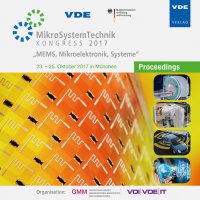Multi-window Transmission Electron Microscopy liquid cell to improve imaging performance
Conference: MikroSystemTechnik 2017 - Kongress
10/23/2017 - 10/25/2017 at München, Deutschland
Proceedings: MikroSystemTechnik 2017
Pages: 4Language: englishTyp: PDF
Personal VDE Members are entitled to a 10% discount on this title
Authors:
Venegas-Rojas, Deybith (Institut für Mikrosystemtechnik, Eißendorfer Straße 42, 21073 Hamburg, Deutschland & Instituto Tecnológico de Costa Rica, Cartago, Costa Rica)
Keskin, Sercan; Azim, Sana; Manz, Stephanie; Miller, R. J. Dwayne (Max Planck Institute for the Structure and Dynamics of Matter, Luruper 149, 22761 Hamburg, Deutschland)
Trieu, Hoc Khiem (Institut für Mikrosystemtechnik, Eißendorfer Str. 42, 21073 Hamburg, Deutschland)
Abstract:
Silicon nitride Si3N4 windows have been widely used in nanofluidic cells for liquid Transmission Electron Microscopy (TEM) because of their stability and good imaging properties. However, the pressure difference between the fluid in the liquid cell and the exterior vacuum required for TEM, generates bulging of the window. This increases the imaged fluid volume, particularly the liquid film thickness, which decreases the signal-to-noise ratio (SNR), limiting the achievable spatial resolution and contrast. This paper presents a study of liquid cells membranes in which we aim to obtain a suitable strategy to solve this problem. We present a study of the windows’ mechanical performance with Finite Element Method (FEM) simulations. Bulging and von Mises stress were studied for different membrane shapes, sizes, thicknesses, the pressure applied, and materials in order to know how these parameters affect the membranes. It was found that high-stress silicon nitride (Si3N4 HS) is an appropriate option as material for liquid cells due to its considerable lower bulging in comparison to the standard low-stress silicon nitride (Si3N4 LS) (28 – 83 %). It provides higher mechanical stability than Si3N4 LS. The circular shape is more suitable to use in windows of liquid cells due to the reduction of bulging (10 – 14 % for LS) when compared with a square shape and its better distribution of the von Mises stress. Silicon oxide (SiO2) is not a proper material because of its higher bulging and its higher probability of fracture for membranes with less than 30 nm in thickness. With these results, a reasonable strategy to reduce the bulging of liquid cells can be implemented, for example, using a circular windows array, with a diameter of 5 -10 µm, and membranes of highstress silicon nitride. This strategy enables a further reduction of the membrane thickness improving the SNR.


